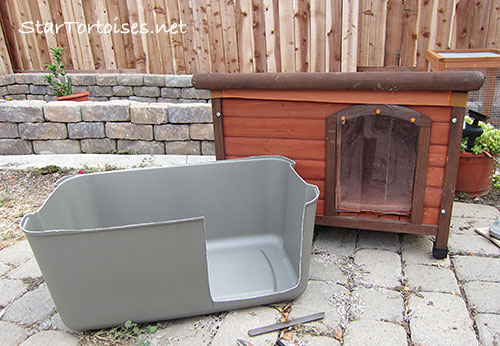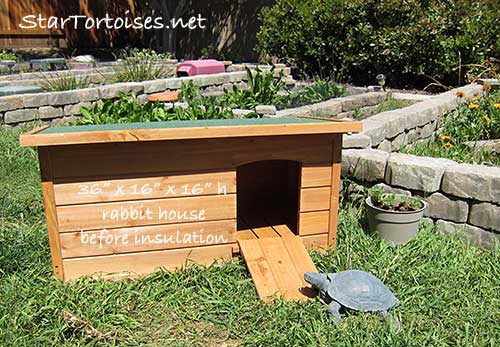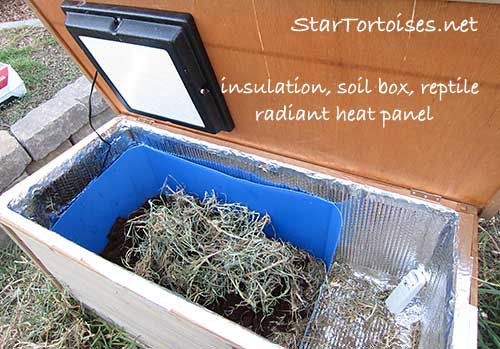


As I've mentioned before, I have no skills or interest in carpentry, so I am always looking for easy to modify products and supplies to use in my tortoise enclosures. This page covers some basic outdoor housing solutions that anyone can do. No special skills needed. :0)
I live in a warm, but not hot, climate. What works for me and my tortoises may not work in other areas. You'll need to adjust your tortoise houses to fit your climate.
See also tortoise houses p.2 for larger houses I use with my Burmese star tortoises.
Hiding places are very important for tortoises' physical and mental well-being. Tortoises in general are timid creatures and need hides that allow them to relax and feel secure. My tortoises prefer to take cover under small bushes or tufts of grass. All my tortoise enclosures have many plants and clumps of taller grass for this purpose.
Shady, cool hiding places protect tortoises from overheating on hot summer days, and heated houses keep them snug and cozy during cold fall and winter nights. Your tortoise may or may not use his house as a voluntary shelter. You probably have to place your tortoise into his house at night, at least in the beginning.
Flat, top opening dog and rabbit houses can be modified for tortoise use. You will have to insulate all the walls, floor and ceiling to make the house airtight and keep the heat in during cold weather. The easiest way is to use insulation foam boards and then cover them with thin wood boards or reflective insulation. Whatever insulation and covering material you choose, it should be safe, nontoxic, and as "tortoise proof" (scratching, digging) as possible. The floor should be waterproof for easy cleanup. Expect to see lots of pee and poo on the floor. :0)
Attach a reptile radiant heat panel or a ceramic heat emitter (CHE) to the ceiling of the compartment. Radiant heat panels are a much better choice because they distribute gentle heat over a large area. I don't use CHE's at all because they get very hot and can cause shell burns if placed too close to the tortoise. For safety, any heater should be thermostatically controlled. See the heating page.
In freezing cold climates, these modified dog and rabbit houses are not warm enough for the winter, unless you place them inside a shed or other structure, but they can still be used as "day and season extenders." Even if you bring your tortoises inside for nights, a heated outdoor house allows them to go out earlier in the morning and come in later in the evening. Heated houses also extend the outdoor season by allowing tortoises to go outdoors earlier in the spring and stay out later in the fall.
For this heated tortoise house I used the smallest size of the Ware Premium Plus dog houses (size small 33 1/2” x 22 1/2” x 23” h). It has the right shape, is low enough, and has a flat, top opening lid. To waterproof the inside, I placed a large plastic tub inside. I cut the tub's sides a bit lower and created an opening for the doorway.
Instead of the usual foam or bubble insulation, I used the matching Ware insulation kit for this house. It's all one piece and just zips and velcros to place. Super easy! If needed, you can add a layer of insulation between the house walls and the insulation kit for better heat retention.
I filled the tub with substrate and attached a thermostat controlled reptile radiant heat panel to the inside of the lid. If more heat is needed, you can attach one or more Zoo Med ReptiTherm heat panels or a Kane heat panels on the walls. Zoo Med heater is available in one size (18" x 18"), but the Kane mats are sold in many sizes.

This 30 gal Sterilite tub (30 1/2” x 20 1/4” x 15 5/8”) fits perfectly inside the house to waterproof it. Sterilite boxes are made of polypropylene and polyethylene that are safe for food storage. According to their website, no PVCs, latex, teflon, phthalates chemicals, fungicides, Bishphenol A (BPAs), or antibacterial chemicals are used in the manufacturing process.

Instead of the usual foam or reflective bubble insulation, I used the matching Ware insulation kit. It's all one piece and just zips and velcros to place. Super easy.

I fill the tub with soil, coconut coir, coco chips, or a mix of them. My current favorite coconut husk chips are medium sized ReptiChips (compressed blocks) and small sized BabiChips (loose) from the ReptiChip company. So far, I have been been very happy with their products. All chips have been clean, odorless, and non-staining.

I attached the thermostat controlled reptile radiant heat panel to the inside of the top lid.

We get rains only in the winter, and even then it's not often. I put a tarp or a piece of plastic over the house during the rainy months for extra water proofing. The door is closed at night if there's no predator protection cage around the house.
I made a heated house for my more delicate, imported golden Mesopotamian Greek tortoises using the largest size (38" x 29") Doskocil (dba Petmate) Aspen Pet Petbarn dog house. I have a bunch of these heavy duty, USA made houses in various sizes. I use them full sized (top and bottom attached), half sized (only top or bottom), unheated, and heated. They do bleach a bit in the sun over time, but otherwise seem to last almost forever.
Tip: During hot summer, a half house like this can be dug into the ground and covered with a thick layer of soil to create a cool summer cave that won't collapse.

For this heated hide I used the bottom of a plastic dog house with a reptile radiant heat panel attached to the ceiling. There is no floor, just soil that my Greeks like to dig into. My Greeks actually prefer this setup over wooden houses with floors. During winter rains, I cover the protection night cage with a camouflage tarp.

I attached the reptile radiant heat panel to the ceiling with nuts, bolts, and washers. The heat panel is hooked up to a thermostat. Triple layer of stripped plastic door flaps keep the heat in.
This Pawhut rabbit coop (16" x 36" x 16" h) is about the right size for a few small tortoises. It is lower than most dog houses and chicken coops, so there's no unnecessary height to heat. The top lid opens for easy access. This well priced rabbit hutch comes with an attached 1/2" hardware cloth pen (no pic) as well that could be used as a night protection cage.

Rabbit house before insulation. A 12" garden statue for scale.

I fastened reflective bubble insulation on the inside. For even better heat retention, you could use an extra layer of styrofoam insulation boards under it. For heat, I attached a reptile radiant heat panel to the ceiling. It's controlled by a simple thermostat.
For scratch proofing I used a large plastic tub, but you could also cover the insulation with thin wood boards. The big plastic tub is waterproof, easy to clean, and made of nontoxic plastic (not pvc). This tub is a little too short, but once I find a better fitting one, I'll switch it.
1.) Heaters
When installing any heating elements on the inside of a tortoise house, be careful. You don't want your tortoise to burn himself or the heating unit to become a fire hazard. Follow manufacturer's installation instructions and ideally use outdoor approved cords and products.
Check the house temps. Always use a thermostat with all types of heating devices when heating small, closed spaces to prevent overheating. Only about 1/3 to 1/2 of the house should be heated if tortoises are locked inside the house at night. This allows them to retreat to a cooler area inside the night box if needed.
The heating system should ideally have some kind of protection against electrical failure, especially in cold climates. Otherwise, your tortoise may be exposed to freezing temperatures and suffer serious injuries or worse.
2.) Fumes
When new, it's best to let all wooden commercial and DIY tortoise houses air well outside in the sun for several days or weeks until the odor from the wood, paint, and glue is gone. I would not lock a tortoise into a house that's full of paint fumes. Always AIR OUT closed houses well before use.
Typically, commercial dog and rabbit houses are built with either cedar or fir wood. Avoid cedar. It is highly aromatic and toxic to tortoises. Fir is a safer choice. If you are building your own, choose lumber that is nontoxic and smells the least.
3.) Electrical cords
I use weatherproof power and extension cord boxes for my temporary, winter time electrical connections to keep them dry from sprinkler water and rain.
The Sockit boxes, aka Dri-boxes, are great. I use the smallest boxes (13.5” x 9.5” x 4.75”) for my thermostats and the medium size boxes (16” x 13” x 6”) work well for a bit larger stuff. The cord openings in the Sockit boxes have gel-like seals to keep water out.
I also protect my outdoor power and extension cord connections with water tight covers. I've tried a couple of different kinds, and I like the capsule type extension cord safety seals shown in the photo below.

Reptile radiant heat panel and weatherproof electricity connection boxes.

Update: In recent years I have switched to these made in the USA Twist & Seal cord connectors for outdoor cords. They have a secure, tight-fitting weather seal. I have also learned to buy all my cords and connectors in bright colors instead of black or green. The vivid colors prevent me from accidentally snipping them when I'm working in the garden with cutting tools.
Related pages: Outdoor tortoise houses p.2, heating